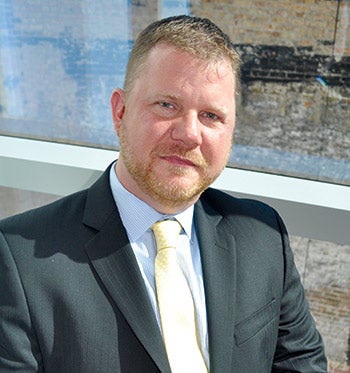Coordinating advocacy efforts for hospital design and operations
 Chad E. Beebe, AIA, SASHE, CHFM, CFPS, CBO, deputy executive director of advocacy for the American Hospital Association’s American Society for Healthcare Engineering (ASHE), talks about the association's work on unified codes and other regulatory initiatives at the start of the new year.
Chad E. Beebe, AIA, SASHE, CHFM, CFPS, CBO, deputy executive director of advocacy for the American Hospital Association’s American Society for Healthcare Engineering (ASHE), talks about the association's work on unified codes and other regulatory initiatives at the start of the new year.
What regulatory issues is ASHE keeping an eye on as we move into the new year?
At ASHE, we maintain what I call an “advocacy radar.” This tracks all the different codes, standards, regulations and guidelines that affect the health care physical environment. There are so many regulations that affect the health care built environment that it’s a task that takes nearly 100 people working tirelessly to represent the best interests of the health care facilities managers, designers, engineers, infection preventionists and, most importantly, the patients. The main effort as we get into the new year will be on three key documents — the National Fire Protection Association (NFPA) 101, Life Safety Code; NFPA 99, Health Care Facilities Code; and the Facility Guidelines Institute’s (FGI’s) Guidelines for the Design and Construction of Hospitals and Outpatient Facilities. All three of these documents just entered into the revision cycles and we are working on their 2018 editions. I suspect that all of these committees will be looking at new provisions that enhance patient satisfaction, increase safety and improve flexibility of the space.
ASHE has been working on unifying the different building codes affecting hospitals. How is that project going?
The unified code project is going extremely well. We have been tremendously successful. We’ve already achieved about 70 percent of our goals for changes to the codes and standards. The purpose of this project has been to look at all of these different codes and standards and align them to reduce the number of conflicts and to eliminate provisions that are outdated. Each committee has a wealth of knowledge to offer the development of the standards; however, the expertise of each committee varies. For example, you can find nurse call requirements in NFPA 99 and in the FGI guidelines. NFPA primarily addresses the technical issues related to installation requirements, while the FGI guidelines addresses the more clinical aspects of nurse call systems such as device type and location. Both documents should reference each other, but they shouldn’t overlap their requirements.
What organizations other than ASHE are involved in the code unification effort?
Just about every standards development organization that you can think of including the NFPA, International Code Council, FGI, Association of periOperative Registered Nurses, and the American Society of Heating, Refrigerating, and Air-Conditioning Engineers. We have successfully proposed more than 500 changes to the documents. Each organization sees the true benefits of working together to unify our codes and standards. Additionally, we are working with the authorities having jurisdiction such as the Centers for Medicare & Medicaid Services (CMS), the Joint Commission, DNV GL and the Healthcare Facilities Accreditation Program in trying to achieve consistency between interpretations and application of all these documents.
One of the big changes coming next year likely will be CMS’s move from the 2000 edition of NFPA 101 to the 2012 edition. What can facilities managers expect to see with the change?
A facility that has been using the categorical waivers that have been allowed for the last three years might not see much of the change at all. Many of these waivers were allowing provisions of the 2012 edition of the code to be utilized in health care facilities. The biggest differences will be in the application of the 2012 edition and how CMS interprets the amendments of their proposed rules.
Similarly, the NFPA 99 is likely to move from the 1999 edition to the 2012 edition. What effects will that have?
The Beebe file |
CV• Architect and certified building official Appointments• National Fire Protection Association (NFPA) Standards Council member |
This, perhaps, might be the biggest change that affects the way we design and build health care facilities. The new risk-based approach significantly changes the game plan for any design and construction project. We used to design health care facilities based on the title on the door and we find requirements for the rooms based on those titles. This is no longer the case. Application of NFPA 99 requirements for medical gas systems, electrical systems, nurse call systems and fire protection requirements all hinge on the initial determination of risk to the patient based on the services being provided. This should create more of an even playing field. For example, a system or equipment that is vital to the patient and that the failure of such system or equipment could lead to the death of the patient has to meet the highest requirements with NFPA 99 commonly referred to as Category 1. There are four categories, with Category 1 requiring the most fail-safe features and Category 4 requiring the least.
Why is there such a long lag between code formulation and code adoption? Can anything be done about that?
Everything that we’ve been talking about in unified code hinges on our ability to adopt the latest edition of the code. We will continue to work with CMS to try and make code adoption more routine. We would like to look at routes that encourage more efficient use of federal resources to adopt codes and standards shortly after they are published, utilizing the American National Standards Institute-accredited processes that the standards development organizations are using. There is really no need to spend a significant amount of federal resources to analyze and inspect the documents that are developed by the nation’s leading subject matter experts and in which federal employees play a part. The committees diligently have been applying lessons learned to each edition of the codes and standards, such as those learned from Hurricane Katrina, the Houston floods, the Northeast blackout of 2003, Hurricane Sandy, and the tornadoes that affected Joplin, Mo., and Moore, Okla. So, it is important that we adopt the current codes.
You recently undertook some initiatives with the Joint Commission to help facilities professionals improve compliance with some of the frequently cited life safety and environment of care standards. What was behind that?
The Focus on Compliance program is a great opportunity to learn about the top eight physical environment standards that are frequently cited during surveys. ASHE collaborated with the Joint Commission and created a physical environment portal that houses the resources that address those top eight citations. We know where the problem areas are and accreditation or compliance isn’t a test. Jointly, we are providing all these test answers to anyone who is interested. Every two months, we will focus on another group of citations, and through the Joint Commission and our website, we will provide tools and resources to help facilities achieve compliance.
Do you foresee more programs like that in the future?
Collaboration is the key to ASHE’s future and to the success of our advocacy program. More and more, we find that everyone involved in health care is after the same thing — improving patient outcomes. I think a great deal of the success we have had so far on the unified code project has been that we often invite and encourage those with different opinions to the table.
Mike Hrickiewicz is editor of Health Facilities Management.




